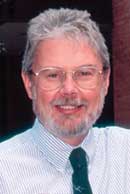by Lee Allison,
Director and State Geologist

The Survey brings not only a wealth of data and expertise, but also a reputation for unbiased assessment of scientific and technical issues
Last
January, in the wake of natural gas explosions in Hutchinson, Governor
Bill Graves ordered the Survey’s seismic crew to come to the aid
of the city. News reports trumpeted the deployment as if reinforcements
were coming to the rescue of beleaguered residents. At that time, the
gas utility was drilling wells around the city to vent natural gas but
only about 20 percent were actually encountering gas. The Survey seismic
crew found two narrow geologic zones carrying gas a few hundred feet below
the city. More importantly, the seismic work, coupled with extensive subsurface
investigations by other Survey geologists, helped guide the continuing
search for gas pockets throughout the city.
The Hutchinson crisis raised the public profile of the Survey and introduced us to some who did not even know we existed. But for many citizens of Kansas, the Survey was already well known. During the past legislative session, for example, Survey scientists were asked to provide expert testimony more than 15 times to a variety of House and Senate committees. We also briefed the Governor and his staff on developing issues. Topics included the rising price of natural gas, energy policy and plans for the state, depletion of the Ogallala aquifer, and the Hutchinson gas explosions.
Survey scientists also respond to hundreds of formal inquiries every year from state and local agencies about geologic impacts or concerns with proposed development projects. The Survey has partnerships with numerous local oil and gas producers to test new methods for extending the lives of our declining petroleum reserves.
With more than a century of geologic investigations and mapping in Kansas,
the Survey brings not only a wealth of data and expertise, but also a
reputation for unbiased assessment of scientific and technical issues.
Because most state agencies are regulatory or enforcement-based, they
often need independent and reliable science. Sometimes, as in Hutchinson,
good information and advice alone are not enough. Sometimes we need to
jump into the situation, come to conclusions on the fly, and make decisions
and recommendations with minimal information.
This is not a style that all scientists are comfortable with, but it’s
one that often confronts geologists. Geology is the science of dealing
with the physical world, a world that can be dangerous. Geological surveys,
whether state or national agencies, deal with landslides, earthquakes,
floods, subsidence, and a variety of other hazards and emergencies.
The Hutchinson explosions were unusual—nothing quite like this had ever happened anywhere in the world. Survey employees—scientists, technicians, and support staff—accepted the challenge and stepped in to help. As we have before. As we will when needed again.
![]()
Survey Expands Public Outreach Program
Last fall the Kansas Geological Survey sponsored its first public field trip, as part of national Earth Science Week. The trip introduced a busload of people to the rocks and fossils of northeastern Kansas. The overwhelmingly positive feedback, plus the long waiting list, prompted the Survey to repeat the trip on April 27 and 28, 2001. Because of the strong interest in these public field trips, the Survey has incorporated them into its Geology Extension program and will run two trips a year, one in the fall and one in the spring. The next trip, scheduled for October 13, 2001, will visit central Kansas. Further details about public field trips are posted on the GeoKansas web site.

Online February 10, 2003
Comments to: lbrosius@kgs.ku.edu
Kansas Geological Survey
URL:http://www.kgs.ku.edu/Publications/GeoRecord/2001/vol7.2/Page2.html